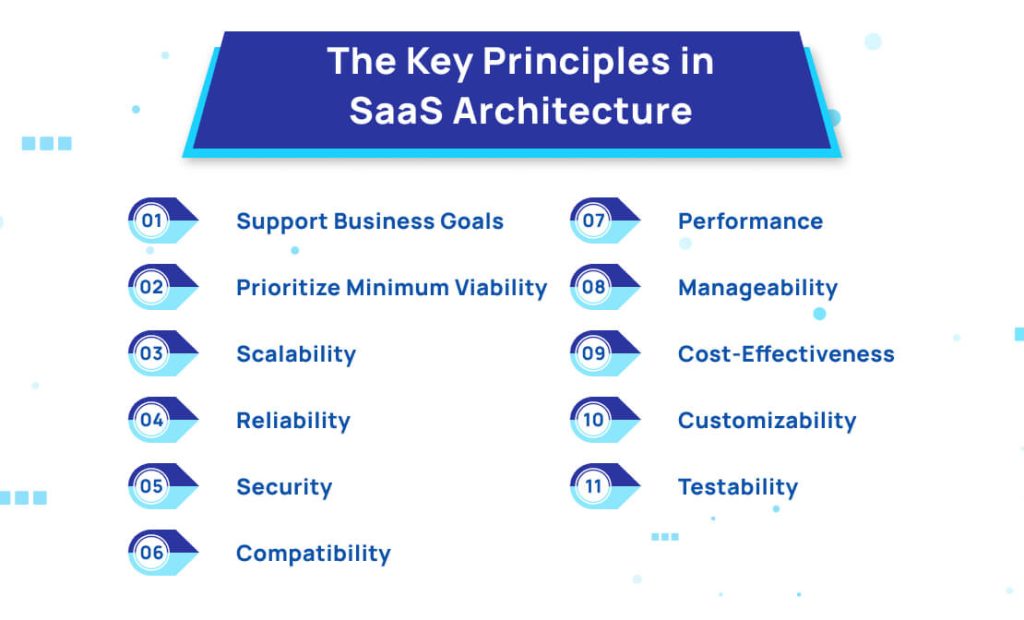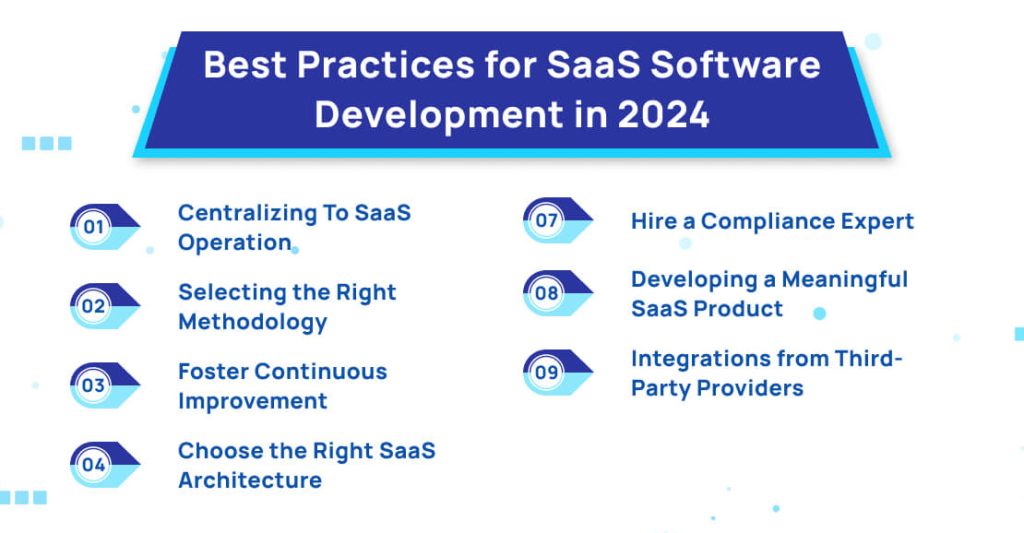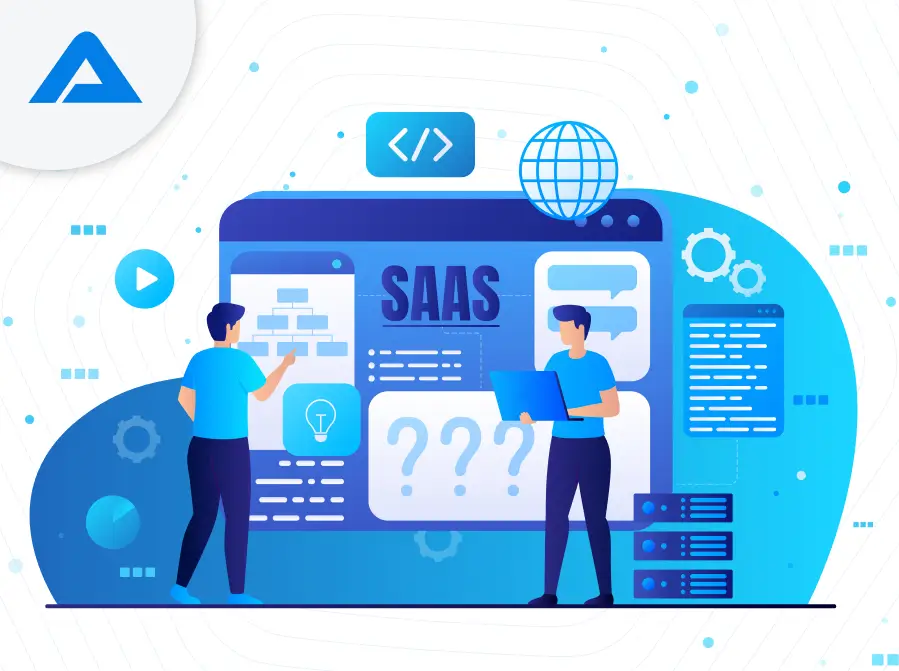CTOs and software architects are responsible for developing new products while optimizing technology costs. Your architecture choice determines how much control you have over infrastructure, data storage requirements, and customization opportunities.
SaaS also frees users from the tasks involved with installing local software, such as purchasing, installing, and supporting it regularly.
Additionally, SaaS reduces maintenance tasks associated with locally installed software – purchasing, installing, and updating. But what exactly is SaaS structure, and why have more businesses adopted SaaS applications over on-premise applications?
Let’s begin by discussing SaaS architecture, then focus on effective practices to guarantee an efficient yet cost-efficient architecture design for SaaS services.
What Is SaaS Architecture?
Are you curious about SaaS architecture?
Software-as-a-service is one of the fastest-growing paradigm shifts in cloud applications and will continue to grow in importance and sophistication. It’s a way to offer software. The service provider hosts one or more programs to provide them to users via the Internet.
The SaaS industry is expanding rapidly, and the model enables several companies to connect to one hosted service and operating system, hardware networks, and other elements.
A company can utilize the same system, and engineers may utilize the Application Programming Interface to customize the SaaS solution to meet the needs of their clients.
It is unnecessary to purchase the complete version to install it on each computer to use it since SaaS providers take care of every technical issue. The ease of access and convenience have made it necessary for companies to embrace SaaS products in a highly extremely competitive market. However, it also presents new issues for technology developers and service providers.
What Makes SaaS Development Unique?
SaaS development is distinctive in that it is software development that needs to be hosted in cloud services that are shared or private in the environment. This presents a myriad of security, performance, compatibility, and user-experience issues not encountered when building applications that are not SaaS-based.
SaaS developers need to integrate a range of cloud security options to ensure their SaaS solutions are safe, like Multi-Factor Authorization (MFA) and minimum-strength password requirements, as well as data encryption and automated cloud backup systems.
SaaS developers should also make sure that they ensure that the SaaS software is compatible with the most recent selection of modern web browsers, including Microsoft Edge for Windows and Safari for Apple iOS and OS. It is also important to consider other browsers for the web, like Google Chrome, Mozilla Firefox, and Opera.
Another feature in SaaS applications that makes them stand out is the capability to increase and reduce the size of an application following its launch. This allows SaaS development company to include or eliminate third-party services, features, plugins, and components that weren’t available when they launched this SaaS application.
This means that SaaS providers can respond to consumer demand and the market by continuously improving their SaaS application long after the initial launch.
SaaS Applications Architecture
Below are some approaches to SaaS application architecture for development.
Multi-Tenant
Multi-tenancy is when one infrastructure can serve multiple customers, the data is shared, and each tenant’s information is secured and separated.
Single-Tenant
Single-tenancy is the term used to describe a situation where each customer utilizes their copy of the software. This SaaS application development model is more secure than the multi-tenancy option; however, maintaining and supporting requires more work.
Horizontal SaaS
Horizontal SaaS applications support many businesses, regardless of their business. Examples include marketing or accounting apps that businesses can utilize across various areas.
Vertical SaaS
Vertical SaaS applications are, in turn, apps designed to cater to a particular business sector. Companies need to be able to use them in different sectors. They are instead greater or less advanced features for various users.
Multi-tenant and single-tenant SaaS architectures, in addition to their different designs, aren’t the only options. If you’re thinking about the best way to create an SaaS application, consider serverless architecture.
Serverless Architecture
It can function in two main capacities: as a Backend-as-a-Service (BaaS), with the application’s backend hosted predominantly in the cloud, or as a Function-as-a-Service (FaaS), executing code in response to diverse event triggers. Functions can be activated when needed, giving businesses many advantages that are too important to ignore.
The Key Principles in SaaS Architecture

The fundamental concepts for SaaS architecture design are the ability to scale, reliability, availability, security, performance, and scalability. There are many more SaaS design guidelines to consider, including those offered through AWS Well-Architected Framework. AWS Well-Architected Framework for SaaS applications.
Here’s a summary of the fundamental principles behind SaaS architectural design.
Support Business Goals
SaaS architecture should be designed to support the goals and objectives of the business. This implies that the architecture must be designed to satisfy the customer’s needs. The purpose of every company is to reap the benefits of satisfying the needs of its customers. So, the attributes of the SaaS architecture must be tailored to the user’s requirements.
Prioritize Minimum Viability
SaaS should be a minimally viable product, which means that the architecture needs to be designed to deliver the core functionality and features at top quality and durability and can add new features in the future.
This can reduce any complexity associated with the structure and reduce the cost of development, deployment, and maintenance. This method also guarantees that the product will be quickly introduced into the market and can be improved incrementally over time.
Scalability
SaaS architectures must be scalable to handle increasing clients and information. That means the structure must accommodate an increase in the number of data and users without causing performance issues.
In particular, the system will be able to increase resources to handle the demands of more users and automatically store more information without any manual intervention or switch to a new platform.
Reliability
Reliability refers to the device’s capability to offer consistently high performance in terms of quality, reliability, availability, speed, etc.
SaaS architecture design should focus on ensuring the application is reliable and available at all hours of the day. This implies that the architecture must be designed to reduce the time it takes to shut down and ensure that users can access the application whenever required.
In particular, a well-hosted application must be developed to identify and correct problems promptly, and the right amount of redundancy needs to be included to ensure there’s no single fault point.
Security
Security ensures the system is secured from unauthorized access to data and data loss. The system should employ adequate security measures to guard the user’s data against unauthorized access, disclosure, modification, or loss.
Here’s an illustration. Utilizing microservices architecture instead of monolithic architecture may reduce the risk of attack and simplify deploying security updates to only the affected components.
Performance
SaaS architectures should give users a great experience. Performance is the speed and effectiveness of the system in providing results. That means the system must be designed to provide the fastest and most responsive user experience.
Take a look at these scenarios. The architecture should minimize the number of interactions between the server and the client. Use caching to lower the response time and an online content delivery network to boost the speed of response.
Manageability
SaaS architectures must be simple for management and maintenance. They must be designed to be easy to update, configure, and troubleshoot. Furthermore, the design must be adaptable enough to change your business’s requirements.
It must also separate all resources belonging to tenants. Additionally, it must provide transparency and control of who can access which information.
Cost-Effectiveness
SaaS architectures should be affordable to manage and maintain compared to IaaS and PaaS services. It must be developed to maximize the use of resources and the associated expenses.
For instance, Amazon Web Services (AWS) SaaS offerings such as Amazon Connect, an online contact center service, are far more affordable than creating an in-house contact center.
Customizability
The SaaS model is designed to ease an organization’s load to manage its structure. There’s no universally applicable SaaS structure, and the system should allow users to modify the software to meet their specific needs.
This is done using APIs or other ways that permit users to modify the system to meet their needs. Additionally, SaaS architectures should be simple to use and self-service able so that users can set them up without needing help.

Testability
The concept of testing in SaaS is to balance testing and quality control processes for all tenants and users.
Conversely, you’d like to implement tests and QA procedures throughout the SaaS application, not just for specific tenants. However, you are aware that all your users are not within the same profile of users.
Additionally, you can test an individual tenant structure before deploying it in a multi-tenant structure and ensure it operates effectively and without error.
Compatibility
It is vital to make sure that your SaaS structure design works with various kinds of users, devices, and system configurations. This will ensure the software functions correctly with all device users, regardless of their surroundings.
In addition to supporting various third-party integrations and services, the architecture should let users connect their existing or favorite applications.
If you follow the SaaS structure design rules, you can ensure that your SaaS implementation is in line with your customers’ needs.
Best Practices for SaaS Software Development in 2024

SaaS (Software as a Service) uses software programs on a web browser without installing them. A SaaS model is growing in popularity in this age of technological globalization, in which geographical location is becoming less and less critical.
Centralizing To SaaS Operation
Companies transitioning to SaaS providers represent an important shift in the way technology, people, and processes work. When organizations transition to SaaS software development and deployment, they must provide these as a service regardless of whether they are in a particular location, sector, or service. The customers have bought a fully managed service that meets the highest standards. Therefore, they should expect to avoid pointing at it and hope it will work correctly.
SaaS-based software eliminates long installations, quality maintenance, and the capability to assist customers and provide periodic updates. These initiatives impact the finance department, operations, and sales. So, the change towards becoming a SaaS provider will force organizations to be more centrally controlled, efficient, unified, and cost-effective.
Silos and inefficiencies could become impossible to maintain, whether internally or partnering with a third party. To prevent mistakes, stay up-to-date, and remain relevant in the cloud age, SaaS application development The SaaS application development process allows companies to make their configurations more uniform, use automation as often as they can, and operate efficiently.
Selecting the Right Methodology
SaaS software engineers and providers generally employ different methods to increase productivity, reduce time, and improve team collaboration. Before SaaS application development begins, the companies and their SaaS providers need to choose the best methodology that matches their strengths and satisfies their business requirements. The most well-known methods for SaaS app development are Agile Iterative, Iterative, and Rapid. Let’s see the way they compare:
The method you choose must be based on the specific requirements of your project. The agile approach, the most well-known of the three, can improve the quality of software and lower development costs. However, it requires a significant amount of cooperation.
Hire a Compliance Expert
Ensure that the SaaS platform complies with all applicable regional and geographical standards by employing a certified compliance specialist.
If outsourcing, ensure that the SaaS development team includes an expert in compliance with their staff. They’ll perform the required quality control to confirm your SaaS platform complies with the most current standards.
Choose the Right SaaS Architecture
At the beginning of development, choosing the correct SaaS platform and architecture is crucial. Numerous types of frameworks are available. However, the two most commonly used are Monolithic Architecture and Microservices Architecture.
Monolithic architecture implies that the whole SaaS platform is based on one big codebase. So, if a modification occurs to the single codebase, it could affect all of the codebase and, therefore, should be re-examined to ensure no interference.
Microservices architecture, on the contrary, implies that the SaaS platform comprises a variety of smaller codebases (or separate units) that work in tandem to let the SaaS platform work effectively.
Foster Continuous Improvement
There is an ongoing SaaS product. There are always new developments and modifications to keep pace with the latest developments.
Promoting a culture that encourages continuous improvement in your team members for development is essential.
Review and regularly assess user feedback along with metrics, user feedback, and market trends to find areas of innovation and improvement.
Always keep an eye out for ways to enhance your SaaS product. This may include introducing new features, solving any issues users might encounter, and staying ahead of your competition.
Developing a Meaningful SaaS Product
SaaS design and development success involves a blend of user-centered design, agile methodologies, security, and constant enhancement.
By following these guidelines, create a SaaS product that meets user requirements and gains an advantage in the marketplace.
Be flexible, open to feedback, and dedicated to continual improvement to guarantee your SaaS product’s long-term viability.
Related Article:- How to Build a SaaS Product from Scratch to Streamline Business Productivity
Integrations from Third-Party Providers
Digital transformation of business involves the digitalization of every aspect of workflow. So, if you develop a specific SaaS, consider the possibility of linking it to different software platforms.
If you are developing software for accountants, you might have to incorporate it into forecasting and analytics systems.
When creating electronic medical records (EHR), You should consider ways to connect them with bill-payer software and insurance companies and portals for patients.
The Key Takeaway
The reality is that the SaaS market is currently expanding. Every day, more and more people are familiar with the possibilities SaaS development services can bring to their daily lives. Small and medium-sized businesses are beginning to recognize that Software as a Service can be a perfect choice for their requirements. This is why joining the SaaS market today could offer great potential and enormous benefits in the near future. But it can be complicated, and you must thoroughly understand how the market works.
There’s no requirement to install separate software on every device. Maintenance of the application is straightforward because the team developing the application can only push updates and QoL enhancements to the single cloud-enabled application without having users upgrade their applications manually every time an update is sent out.
Utilizing these SaaS best practices can assist you in identifying and addressing the challenges of customers. This way, you can achieve your goal of reducing the rate of churn, increasing the value of a customer’s lifetime, and increasing customer retention.
Be flexible, remain attentive to your customer’s needs, and, most importantly, remain creative. By incorporating the following SaaS best practices in your toolkit, your solution can make its mark in a highly competitive market by capturing hearts and a large market share.

Are you looking for trusted developer to build SaaS product for your business?

Pooja Upadhyay
Director Of People Operations & Client Relations

